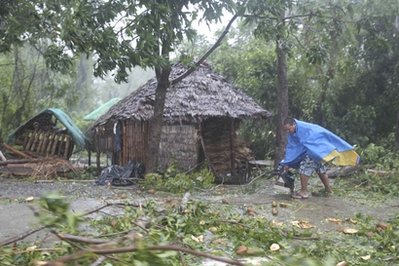Asia-Pacific
Super typhoon lashes Philippines, kills at least 3
(Agencies)
Updated: 2010-10-19 06:26
 |
Large Medium Small |
CAUAYAN, Philippines – The strongest cyclone in years to crash into the Philippines killed at least three people Monday, leaving a wasteland of fallen trees and power poles and sending thousands scampering to safety in near-zero visibility. A retired general said bracing for the onslaught was like preparing for war.
 A resident prepares to cut fallen trees blocking the highway at the onslaught of typhoon Megi Monday Oct 18, 2010 at Cauayan, Isabela province in Philippines. [Photo/Agencies] |
Super Typhoon Megi, blowing across the northern Philippines, was forecast next to head toward China and Vietnam, where recent floods unrelated the storm have caused 30 deaths.
| ||||
Megi packed sustained winds of 140 miles (225 kilometers) per hour and gusts of 162 mph (260 kph) as it made landfall midday Monday at Palanan Bay in Isabela province, felling trees and utility poles and cutting off power, phone and Internet services. Its ferocious wind slightly weakened while crossing the mountains of the Philippines' main northern island of Luzon.
With more than 4,150 Filipinos riding out the typhoon in sturdy school buildings, town halls, churches and relatives' homes, roads in and out of coastal Isabela province, about 200 miles (320 kilometers) northeast of Manila, were deserted and blocked by collapsed trees, power lines and debris.
One man who had just rescued his water buffalo slipped and fell into a river and drowned in Cagayan province, near Isabela. A woman was pinned to death when a tamarind tree crushed her house and injured her child in Kalinga province, and a security guard died after being struck by a pine tree in nearby Baguio city, officials said.
At least six were injured in the region by falling trees, collapsed roof and shattered glass, officials said.
As it crashed ashore, the typhoon whipped up huge waves. There was near-zero visibility and radio reports said the wind was so powerful that people could not take more than a step at a time. Ships and fishing vessels were told to stay in ports, and several domestic and international flights were canceled.
The entire Isabela province lost power along with 16 of Cagayan's 28 towns as the typhoon blew by. Cagayan Governor Alvaro Antonio said the wind was fierce but blew high from the ground, sparing many ricefields ready for harvesting.
Although initial casualties were low compared to past storm disasters, retired army Maj. Gen. Benito Ramos, who heads the country's disaster-preparedness agency, expressed sadness over the deaths. Bracing for the typhoon, he said, was like "preparing for war."
"This was tougher because in war, I could take a nap," Ramos said.
Thousands of military reserve officers and volunteers were on standby, along with helicopters, including six Chinooks that were committed by US troops holding war exercises with Filipino soldiers near Manila, Ramos said.
In July, an angry President Benigno Aquino III fired the head of the weather bureau for failing to predict that a typhoon would hit Manila. That storm killed more than 100 people in Manila and outlying provinces.
This time, urgent preparations included evacuations and the positioning of emergency relief and food supplies days before the typhoon hit. The capital was expected to avoid any direct hit, though schools were closed.
Megi was the most powerful typhoon to hit the Philippines in four years, government forecasters say. A 2006 howler with 155-mph (250-kph) winds set off mudslides that buried entire villages, killing about 1,000 people.
In Vietnam, officials say up to 31.5 inches (800 millimeters) of rain have pounded areas in just a few days, forcing 126,000 people to flee their homes. Earlier flooding this month left more than 80 people dead or missing.
Megi could add to the misery.
"People are exhausted," Vietnamese disaster official Nguyen Ngoc Giai said by telephone from Quang Binh province. "Many people have not even returned to their flooded homes from previous flooding, while many others who returned home several days ago were forced to be evacuated again."
China's National Meteorological Center said Megi was expected to enter the South China Sea on Tuesday, threatening southeastern coastal provinces. The center issued its second-highest alert for potential "wild winds and huge waves," warning vessels to take shelter and urging authorities to brace for emergencies.
Nearly 140,000 people fled homes in the southern island province of Hainan, where heavy rains left thousands homeless over the weekend, the Xinhua News Agency reported Monday.
Thailand also reported flooding that killed at least four people, submerged thousands of homes and vehicles and halted train service. It also prompted the evacuation of nearly 100 elephants from a popular tourist attraction north of the capital.



